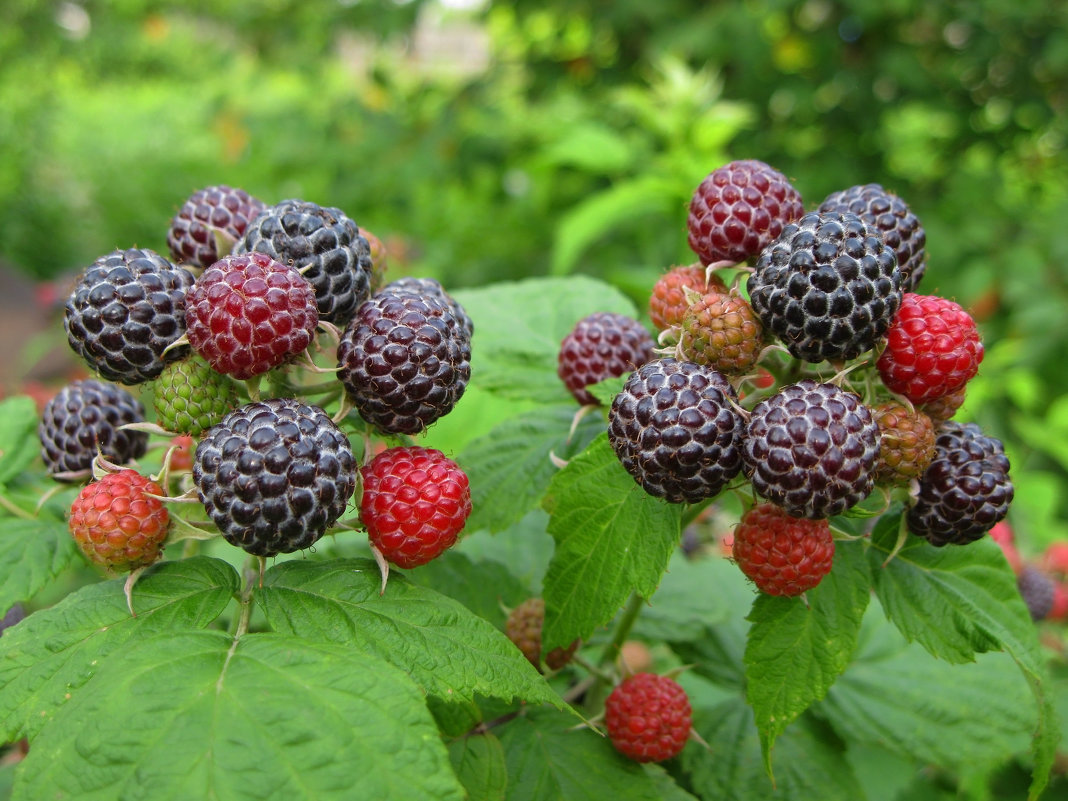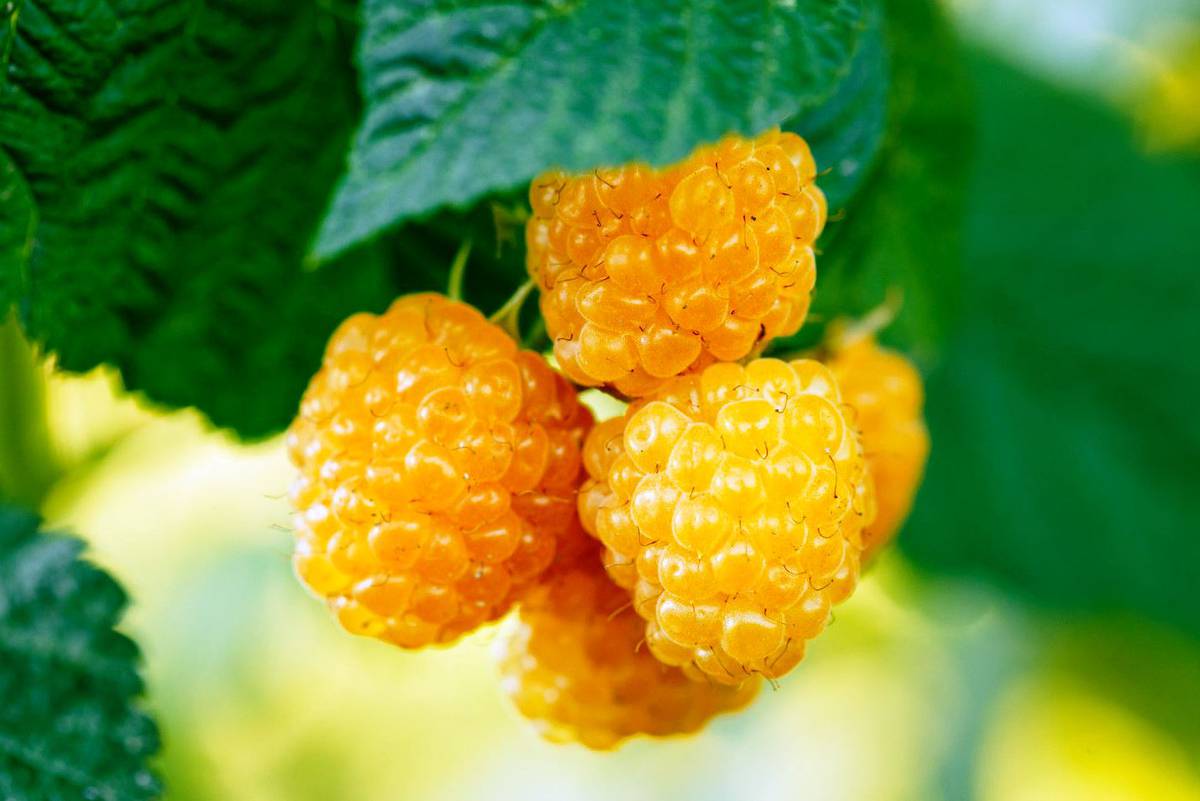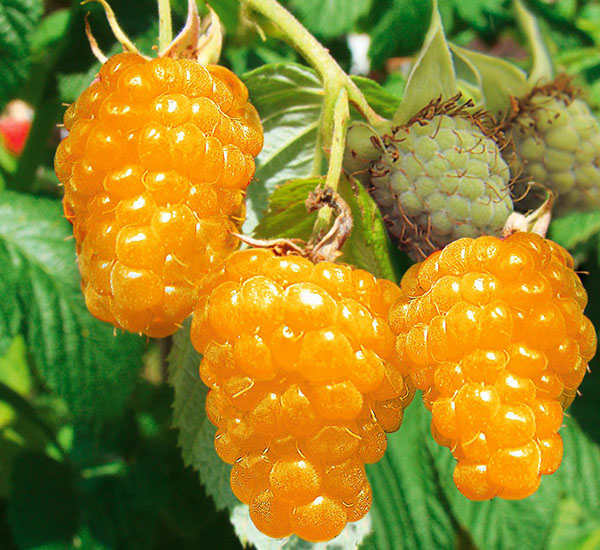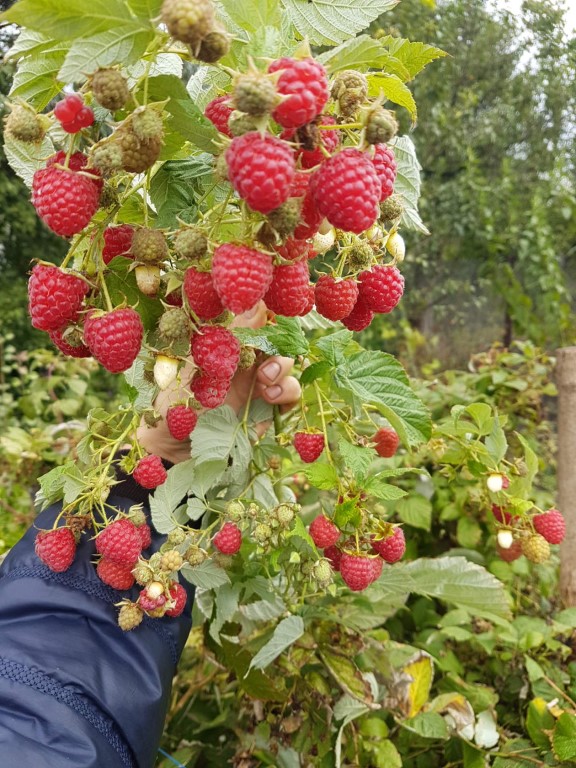Content:
The best decoration of the plot in the country will be the garden raspberry Heritage. This variety has a high yield, which is a determining factor for gardeners in 80% of cases - a large and sweet berry will successfully complement the table, will become the basis for winter harvesting. The high content of vitamins, good preservation make the variety one of the most popular among gardeners.
Features and characteristics of the variety
Breeders bred the variety at the end of the 60s of the 20th century. The bush differs from other varieties in that it is powerful and does not take up a lot of space on the site (it is compact), but at the same time it is tall, which allows you to get a large harvest, saving space on the site, to make elements of the "hedge". The height of the raspberry bush is an average of 1.5 meters, but there are specimens reaching an impressive 2 meters.
The peculiarity of the Hariteage raspberry is that it has strong and thick branches that are slightly raised at the base. Shoot formation occurs in moderation, which avoids pruning too often. They grow straight, therefore, the berry does not interfere with other bushes, plants and trees.
The raspberry bush has long stalks. The leaves of this variety have a rich dark green color, they are small. Leaf features:
- Have pointed ends;
- Wrinkled;
- Oblong.
The variety is distinguished by a low number of thorns, compared to other types of raspberries, which makes it easier to pick ripe berries. The thorns are clearly visible, as they are dark in color, the location is shoots.
Another important characteristic is the characteristics of the berries. The fruit, that is, each ripe raspberry, is medium in size, relative to other species and varieties, the weight of each berry is about 3-4 g. The color of ripe fruits is bright - rich dark red, the shape of the berry is correct conical, therefore it is a table decoration or dishes from it.
Differs in small grain size. Taste characteristics - sweet pleasant taste and rich, but delicate aroma. There is a light, refreshing acidity.
The flowering period for this variety begins in the 20th of July. It takes about 2 months from the beginning of the growing season to the moment of active flowering. Tasty raspberry remontant Heritage is distinguished by a beautiful flowering period, since, first of all, flowers appear on the upper shoots, then they cover the middle of the bush. Last but not least, the lower branches bloom.
The increased productivity and ease of maintenance are explained by the fact that the flowers of the plant have the ability to self-pollinate. Thanks to this, the fruits quickly and easily begin their formation.

View of ripe berries on a bush
The ripening period starts from 15 August. The fruiting period is long - the berry can be harvested until the first half of October. Heritage repair raspberries differ from ordinary varieties in that ripe berries can remain on the branches for a long time, since they do not crumble. Fresh berries without special storage methods can last up to 14 days. To do this, you need to provide a special microclimate: air temperature - +4, air humidity - high. Yield indicators are high - up to 3-5 kg of berries can be harvested from one bush, it turns out that according to this indicator, the variety compares favorably with others. In addition, in the warm regions of the country, it is possible to remove 2 full crops from the bush.
Another important parameter that needs to be taken into account is the possibility of transportation or other type of movement. Berries, even quite ripe and juicy of this variety, are distinguished by the fact that they retain their shape well in the process of moving from one place to another.
Note. The raspberry variety "Heritage" has a pronounced and scientifically proven resistance to a variety of diseases and pests typical for plantings of this kind.
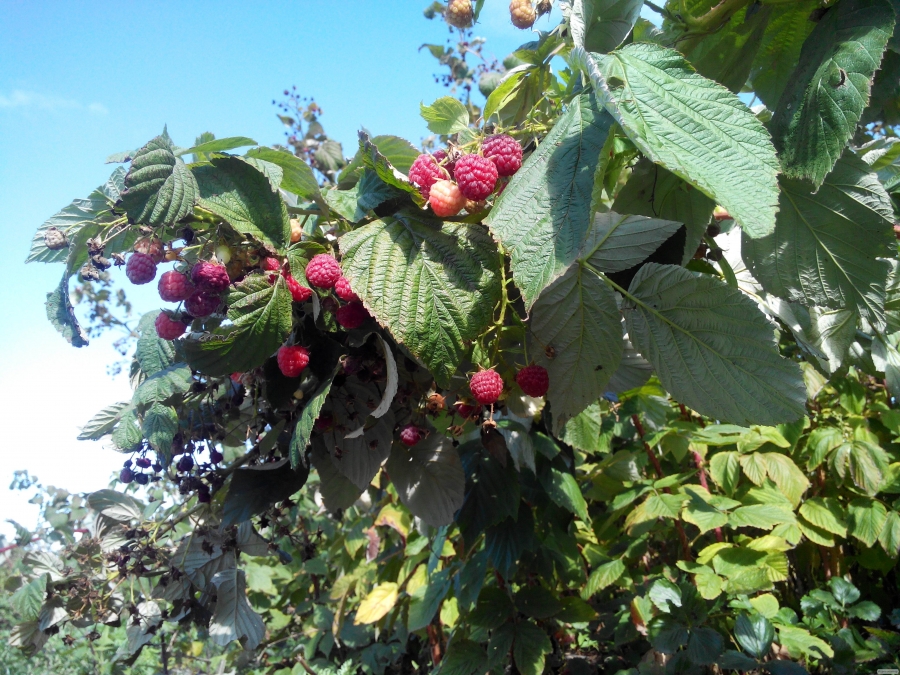
Maturation occurs up to twice a year
It will also be interesting for gardeners that the resistance to low temperatures, which are inevitable in winter, especially when there is little snow cover, and significant autumn cold snaps, in this species of raspberry is very high, which allows plants to successfully survive the winter without special shelter. The roots will not die or be damaged, even if the air temperature drops to minus 20 degrees. At the same time, insufficient snow cover, high humidity, damage by various diseases and harmful insects in the ground can weaken the plant, cause significant damage to growing or recently planted bushes.
Care
In order to grow this variety of raspberries and get a good harvest, you need to follow the rules related to planting and care. The timing and location of boarding must be taken into account. The optimal period for planting a bush in a new place is September. In this case, the seedling will have time to take root quite well. The first crop can be harvested next season in August. It is necessary to take into account a feature that will help maintain health for the shrub directly and the quality of the harvested berries: the most suitable place for placing a shrub is a zone where there is loose fertile soil, it should be located on the south side.
Lighting
The lighting should be good, because if the bush is in the shade, then the yield decreases markedly, and the size of the berry decreases. Raspberry Heritage does not like strong or long-term shadow, so the place to plant it must be chosen carefully. There are special requirements for the soil where the bush should grow.
Requirements for creating ideal soil
Planting should take into account the acidity factor of the soil. The soil must be loose so that oxygen and nutrients can freely flow to the root system. Sod-podzolic soils are excellent for the Harityage variety.
Particular attention should be paid to the amount of moisture in the area - its excess harms the plant. Therefore, areas unsuitable for bushes are lowlands, depressions, places where water stagnates for a long time after rains or irrigation.
If you need to plant seedlings in the spring, you need to prepare the soil in advance, this should be done before winter. Autumn planting will require site preparation 30 days before the procedure. Additionally, the land for raspberry bushes can (and sometimes must be mandatory) supplemented with organic substances and mineral fertilizers.
Features: – 1 m² the area allotted for bush planting of raspberries must be made:
- Potassium (sulphate is selected for the purpose of fertilization) - about 32 g (the amount varies and depends on the quality of the fertile soil);
- Organic - 10-12 kg (ready-made or compost).
You will also need to add some phosphorus substances (about 60 g). For the rapid and confident growth of a newly planted plant, the soil should be neutral in terms of acidity, or a slightly acidic option is allowed, which will be an ideal agricultural solution. Since raspberries of this variety do not like moisture, you need to make sure that the level of groundwater does not rise above 1.5 meters in places where bushes are planted. If the soil is acidic, phosphorus supplements are required.
Cropping: Needed or Not
Raspberry Heritage assumes timely pruning in spring and autumn. Also, during the ripening and formation of fruits, you need to constantly water the bushes.Features of pruning: in October, you need to cut off shoots that are already 2 years old at the very root. In April (spring pruning), those shoots that froze during the winter period are removed and become dry. All branches damaged for various reasons are also deleted.
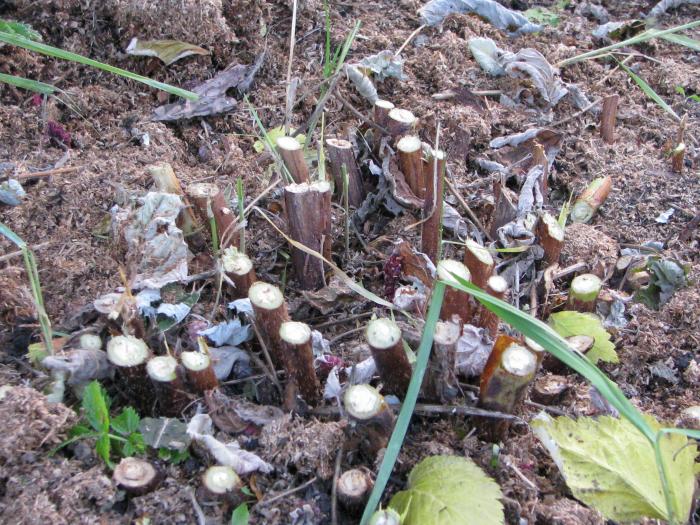
Pruning must be done to keep the shrubs healthy, strong and strong
If the crop is harvested 1 time per calendar year, then the main pruning is carried out in the middle of the autumn period. At this moment, good gardeners remove all branches from the bush to the base. In the spring of the young shoots that have grown, only strong and strong ones are left. Feature - their total number should be no more than 6 branches.
Plant pests
This variety has excellent resistance to environmental conditions and diseases. The plant easily resists various pests that settle on the bush. However, you need to take special measures against the shoot or leaf aphid. This insect is small in size, green in color. The main way of feeding is extracting juice from the leaves. You can find the pest on the inner (opposite to the sun) side of the leaf plate, since it is there that aphids gather, forming small groups for further reproduction. The damage to the plant from the insect lies in the fact that aphids can reduce the number of ovaries, the growth of shoots also stops, damaged leaves dry out or turn yellow.
Pest - stem gall midge
A varietal pest significant for productivity is stem gall midge. The pest is easily identified by its bright orange color. The length is 2 mm. The larva lives and develops under the bark of the bush, feeds, respectively, on its juice. It is possible to determine that a raspberry bush is affected by stem gall midge by swelling of the stems by 2-3 cm.The bark on the stems begins to actively damage and noticeably (upon visual inspection) crack. Also, new shoots become weak and gradually but continuously, but inevitably dry up.
Pest - raspberry walnut
It can seriously spoil the condition of the bush. She is a small insect. The new generation develops directly on the bark of the trunk of the damaged bush, in its upper part closer to the leaves. Gradually formed larvae begin to feed on the juice of the stems, as a result of this, the shoots swell, which is noticeable upon visual inspection, - the branches of the bush become excessively fragile, which leads to the fact that the leaves on them do not receive the volume of nutrients and liquid they should have, therefore, they gradually dry out ...
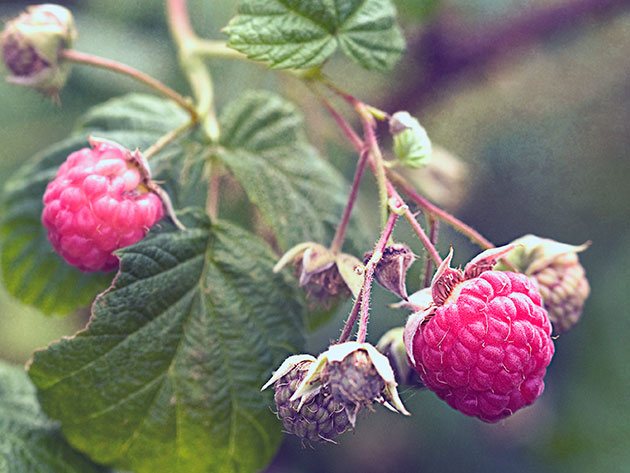
Shrub pests damage leaves and reduce berry weight
Garter features
In order for the ripening process to be stable, you need to tie up the bushes, guided by the existing rules. There are several types of the procedure:
- A simple garter (carried out in 80% of all cases of such care) - a support made of wood or metal is used for this purpose. The optimal diameter is about 4.5-5 cm. It must be installed in the middle of a raspberry bush (one, not several), and its stems are better tied for reliability in bundles, which include 5 healthy branches at once. They need to be tied at a meter level and 20 cm from the ground;
- The garter is fan-shaped - in this case, the supports, also made of wood or metal not damaged by rust, must be strengthened between the bushes, then part of the shoots from the bushes located in the neighborhood must be tied to them;
- The garter on the trellis is carried out when the bushes have been planted in a special way - the tape method. It is installed at the end and beginning of each of the rows. Pull the wire between them in 2 rows. The height of the trellis is 2 meters, the height between the wires is 1 meter. Each shoot must be carefully tied to the wire separately.
Such care ensures timely ripening, proper development of young shoots.
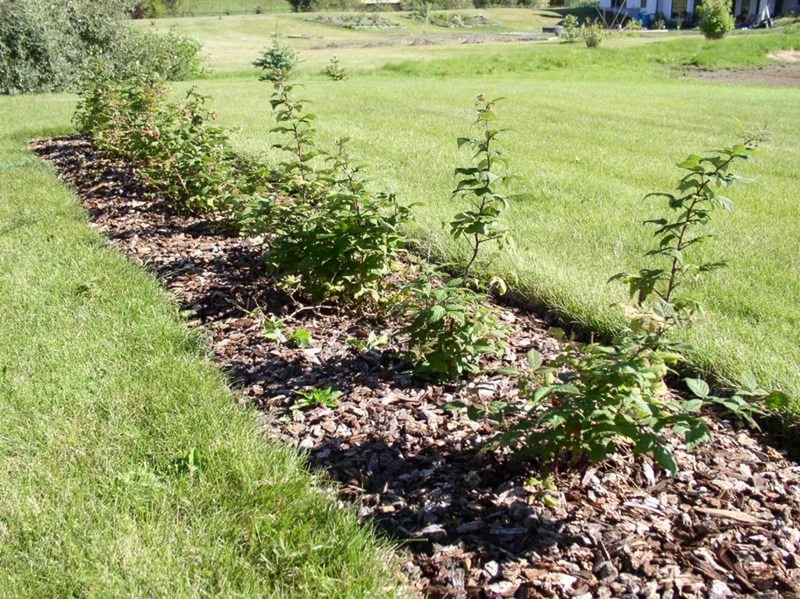
Garter of raspberry bushes
The remontant variety Heritage raspberry, the descriptions of which make it possible to understand all the advantages of choice, helps to get bountiful harvests. Varietal care involves timely pruning, abundant watering and protection from pests, for which Heritage is a convenient place for larval development.
